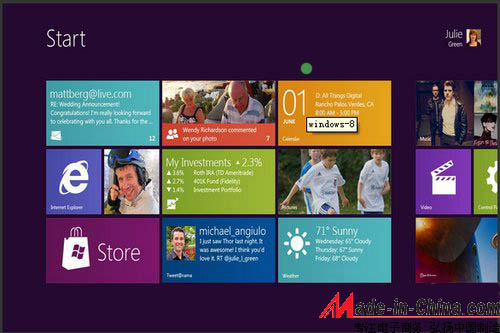 At 24:00 on September 13th, Beijing time, Microsoft presented the first Windows 8 to developers around the world at the 2011 Global Developer Conference (BUILD) held in Anaheim, California. The preview version, although it is a preview version, but people familiar with Windows 7 know that the predecessor Win 7 release is also so Build XXX, Build XXX all the way over, and the preview version and the final version of the difference is not big, so now we can from This preview version of Windows 8 spoke to Microsoft's wild expectations.
At 24:00 on September 13th, Beijing time, Microsoft presented the first Windows 8 to developers around the world at the 2011 Global Developer Conference (BUILD) held in Anaheim, California. The preview version, although it is a preview version, but people familiar with Windows 7 know that the predecessor Win 7 release is also so Build XXX, Build XXX all the way over, and the preview version and the final version of the difference is not big, so now we can from This preview version of Windows 8 spoke to Microsoft's wild expectations. First, support for ARM chipsets - Aiming for tablet support for ARM can be said to have attracted the most attention from people. The Windows system has finally opened up from the closed X86. Simply put, under the X86 architecture, users can only use X86-supported CPUs, only two: Intel and AMD, and under the ARM architecture, the most famous NVIDIA, Qualcomm and Texas Instruments CPU options. ARM is currently used in mobile platforms (including smart phones and tablet computers). From here, we can see that Microsoft hopes that its own Windows will also occupy the pockets and backpacks of its users just like Apple iOS and Android. After all, Windows 7 is because of itself. The reason for high system requirements is that not all tablets can be used smoothly. Now that tablets are becoming more and more popular and they continue to stick to desktops and laptops, Microsoft is likely to fall behind.
Second, Metro style and touch operation optimization - to lead the trend To be honest, at first glance to see Metro style Windows 8 (see the picture at the beginning of the article) I thought of Windows Mobile 7, Microsoft's operating system on the phone. Metro style is the current trend of software, and it is in line with the browsing mode of mobile phones and tablet computers. Not to mention whether so many softwares are suitable for Metro, for the Microsoft that wants to squeeze into the tablet market, Metro style adoption is also taken for granted. In addition, Microsoft has optimized the touch operation so that users are no longer limited to traditional input devices such as keyboards and mice, and can operate more freely, freely, and naturally. This is in line with modern people's demands for simple life. Although the current touch operation is still limited to mobile phones and tablets, but driven by Windows 8, soon we can use a 24 inch display with their own fingers to open a folder.
Third, instant start - to enhance the experience Windows 8 uses a new dormant mechanism, so that all kinds of computer equipment can instantly start. Tests have confirmed that the device with Windows 8 has the slowest start-up time of about 30 seconds. If it is used on a tablet computer, the battery life is improved, and it is enough to take the iPad and other Android tablets for 10 hours or less.
Fourth, Windows Store - split the application store to see the name you have not thought of anything? Correct! AppStore! Like Apple's AppStore, Windows Store is Microsoft's application store. With Microsoft's influence, there will be a large number of developers making programs for users to purchase. It seems that Apple has earned a lot of money on the App Store and Microsoft can't help but reach out.
Fifth, performance enhancements - defense relative to Windows 7, Windows 8 in performance, security, stability has made no small progress, reduce memory footprint, so that low-end hardware can run smoothly. If the above five points are Microsoft's "attack" in face of the new situation, then this should be regarded as Microsoft's "conservation" measures, hoping to maintain or even expand the market share of traditional computer operating systems.
Bolted Silo,Grain Dryer Co., Ltd. , http://www.nsgraindryer.com